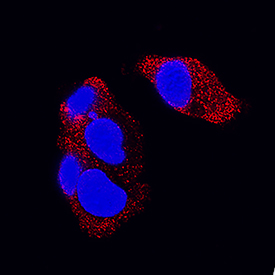Human FGF-21 Antibody Summary
His29-Ser209
Accession # Q9NSA1
Applications
Please Note: Optimal dilutions should be determined by each laboratory for each application. General Protocols are available in the Technical Information section on our website.
Scientific Data
 View Larger
View Larger
Detection of FGF‑21 in HepG2 Human Cell Line by Flow Cytometry. HepG2 human hepatocellular carcinoma cell line was stained with Mouse Anti-Human FGF-21 Monoclonal Antibody (Catalog # MAB25372, filled histogram) or isotype control antibody (Catalog # MAB0041, open histogram), followed by Allophycocyanin-conjugated Anti-Mouse IgG F(ab')2Secondary Antibody (Catalog # F0101B). To facilitate intracellular staining, cells were fixed with paraformaldehyde and permeabilized with saponin.
 View Larger
View Larger
FGF‑21 in HepG2 Human Cell Line. FGF-21 was detected in immersion fixed HepG2 human hepatocellular carcinoma cell line using Mouse Anti-Human FGF-21 Monoclonal Antibody (Catalog # MAB25372) at 25 µg/mL for 3 hours at room temperature. Cells were stained using the NorthernLights™ 557-conjugated Anti-Mouse IgG Secondary Antibody (red; Catalog # NL007) and counterstained with DAPI (blue). Specific staining was localized to cytoplasm. View our protocol for Fluorescent ICC Staining of Cells on Coverslips.
Reconstitution Calculator
Preparation and Storage
- 12 months from date of receipt, -20 to -70 °C as supplied.
- 1 month, 2 to 8 °C under sterile conditions after reconstitution.
- 6 months, -20 to -70 °C under sterile conditions after reconstitution.
Background: FGF-21
Fibroblast growth factor 21 (FGF-21) is a member of the FGF gene family, which currently contains 22 human members. Based on its structure, it is further classified as an FGF-19 subfamily member. This subfamily includes FGF-19, -21, and -23. Like all other FGF subfamilies, FGF-19 subfamily members contain a 120 amino acid (aa) core FGF domain that exhibits a beta -trefoil structure (1, 2). Unlike other FGF subfamilies, FGF-19 subfamily members apparently exhibit poor binding to ECM, resulting in highly diffusible molecules (3). The cDNA for FGF-21 predicts a 209 aa polypeptide that contains a 28 aa signal sequence and a 181 aa mature region (4). Notably, FGF-21, as well as FGF-19 show limited binding to heparin (4). One potential alternate splice form has been reported. It shows a 43 aa substitution for the C‑terminal 12 aa of the standard form (5). Mature human FGF-21 shows 81% aa identity to mouse FGF-21, and is known to be active on mouse cells (4, 6). The FGF‑19 subfamily is considered endocrine in nature. All three subfamily members impact some aspect of metabolism, all three are induced by a nuclear receptor heterodimer that includes RXR, and all three utilize Klotho family members for signal transduction (7, 8, 9). FGF-21 is produced by hepatocytes in response to free fatty acid (FFA) stimulation of a PPARa/RXR dimeric complex (3, 7, 10, 11). This situation occurs clinically during starvation, or following the ingestion of a high-fat/low-carbohydrate diet. Upon FGF-21 secretion, white adipose tissue is induced to release FFAs from triglyceride stores. Once FFAs reach hepatocytes, they are oxidized and reduced to acetyl-CoA. The acetyl-CoA is recombined into 4-carbon ketone bodies (acetoacetate and beta -hydroxybutyrate), released, and transported to peripheral tissues for TCA processing and energy generation (11, 12).
- Itoh, N. and D.M. Ornitz (2004) Trends Genet. 20:563.
- Mohammadi, M. et al. (2005) Cytokine Growth Factor Rev. 16:107.
- Huang, X. et al. (2006) Mol. Carcinog. 45:934.
- Nishimura, T. et al. (2000) Biochim. Biophys. Acta 1492:203.
- GenBank Accession #: EAW52401 (2006).
- Ford, A.M. et al. (2005) J. Clin. Invest. 115:1627.
- Moore, D. D. (2007) Science 316:1436.
- Ogawa, Y. et al. (2007) Proc. Natl. Acad. Sci. USA 104:7432.
- Kurosu, H. et. al. (2007) J. Biol. Chem. 282:26687.
- Lundasen, T. et al. (2007) Biochem. Biophys. Res. Commun. 360:437.
- Badman, M.K. et al. (2007) Cell Metab. 5:426.
- Inagaki, T. et al. (2007) Cell Metab. 5:415.
Product Datasheets
FAQs
No product specific FAQs exist for this product, however you may
View all Antibody FAQsReviews for Human FGF-21 Antibody
There are currently no reviews for this product. Be the first to review Human FGF-21 Antibody and earn rewards!
Have you used Human FGF-21 Antibody?
Submit a review and receive an Amazon gift card.
$25/€18/£15/$25CAN/¥75 Yuan/¥1250 Yen for a review with an image
$10/€7/£6/$10 CAD/¥70 Yuan/¥1110 Yen for a review without an image

